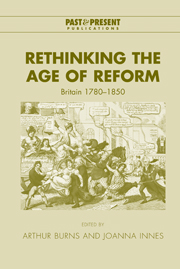Book contents
- Frontmatter
- Contents
- Notes on contributors
- Preface
- List of abbreviations
- 1 Introduction
- 2 ‘Reform’ in English public life: the fortunes of a word
- 3 Parliament, the state, and ‘Old Corruption’: conceptualizing reform, c. 1790–1832
- 4 ‘Old wine in new bottles’: the concept and practice of law reform, c. 1780–1830
- 5 English ‘church reform’ revisited, 1780–1840
- 6 Medicine in the age of reform
- 7 British antislavery reassessed
- 8 ‘The age of physiological reformers’: rethinking gender and domesticity in the age of reform
- 9 Reforming the aristocracy: opera and elite culture, 1780–1860
- 10 Reform on the London stage
- 11 Reforming culture: national art institutions in the age of reform
- 12 Irish reform between the 1798 Rebellion and the Great Famine
- 13 Empire and parliamentary reform: the 1832 Reform Act revisited
- 14 Reforms, movements for reform, and possibilities of reform: comparing Britain and continental Europe
- Index
- Past and Present Publications
5 - English ‘church reform’ revisited, 1780–1840
Published online by Cambridge University Press: 15 December 2009
- Frontmatter
- Contents
- Notes on contributors
- Preface
- List of abbreviations
- 1 Introduction
- 2 ‘Reform’ in English public life: the fortunes of a word
- 3 Parliament, the state, and ‘Old Corruption’: conceptualizing reform, c. 1790–1832
- 4 ‘Old wine in new bottles’: the concept and practice of law reform, c. 1780–1830
- 5 English ‘church reform’ revisited, 1780–1840
- 6 Medicine in the age of reform
- 7 British antislavery reassessed
- 8 ‘The age of physiological reformers’: rethinking gender and domesticity in the age of reform
- 9 Reforming the aristocracy: opera and elite culture, 1780–1860
- 10 Reform on the London stage
- 11 Reforming culture: national art institutions in the age of reform
- 12 Irish reform between the 1798 Rebellion and the Great Famine
- 13 Empire and parliamentary reform: the 1832 Reform Act revisited
- 14 Reforms, movements for reform, and possibilities of reform: comparing Britain and continental Europe
- Index
- Past and Present Publications
Summary
‘Church reform’ is one of the most widely deployed concepts in ecclesiastical historiography. In the modern English context, it moved seamlessly during the late nineteenth and early twentieth centuries from being of central importance in the discussions of ecclesiastical policy-makers to assume a place as a key category in the conceptual apparatus of historical inquiry into the shaping of the Victorian Church of England. From the late 1950s to the early 1970s, the heroic age of ecclesiastical and institutional historiography of the nineteenth-century church, it was ubiquitous. The ecclesiastical reforms of the first half of the nineteenth century were indeed unprecedented in extent, including as they did the redrawing of the diocesan map of England and Wales, a systematic reallocation of church revenues both geographically and between different levels of the church hierarchy, and significant new statutory regulation of clerical practice. While other projects of the ‘age of reform’ attracted a resurgence of interest during the 1990s, however, this did not extend to its ecclesiastical dimension, even though ‘religious’ dimensions of modern British history were also attracting renewed attention.
Why? The answer lies partly in intellectual fashion. Many Hanoverian historians still unconsciously marginalize the theological or religious dimensions of their subjects. But historians of modern British religion are as much to blame. They escaped their professional marginalization of the 1960s and 1970s through significant advances in the social history of religion, studies focusing on popular belief and culture, and considerations of the religious dimension of the ‘history of ideas’, all of which had important implications for ‘secular’ histories.
- Type
- Chapter
- Information
- Rethinking the Age of ReformBritain 1780–1850, pp. 136 - 162Publisher: Cambridge University PressPrint publication year: 2003
- 1
- Cited by

